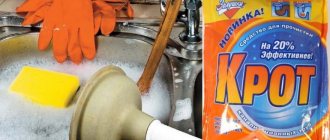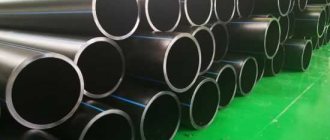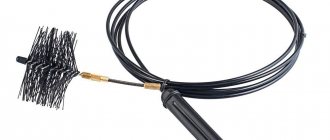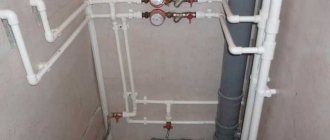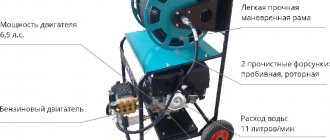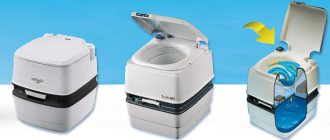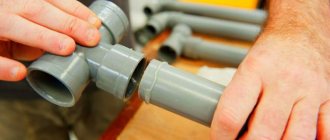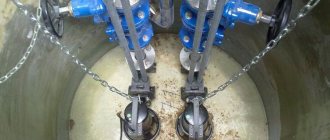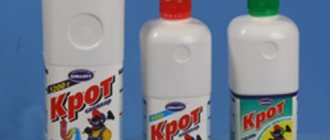Hello again!
Did you know that such a surprisingly simple device as a plumbing cable was invented relatively recently, at the end of the 19th century (in 1896). It was invented by the American inventor John Wrigley, and it was intended for cleaning toilets. The enterprising American received a patent for his invention, and already at the beginning of the 20th century, the simple device was on the advertising brochures of that time.
Since then, the design of the plumbing cable has changed little; it still remains one of the most effective means of dealing with sewer blockages. By the way, the photo shows exactly the same progenitor of all modern cables (scanned copy of a patent received by John Wrigley).
What is it and why is it needed
A plumbing cable is a device for cleaning sewer pipes and breaking through blockages that have formed in them. Due to its resemblance to a snake, the device received the nickname “cobra”.
The basis of the design is a long flexible steel strip or wire coiled into a spring. A handle is installed on one side of it: it sets the “cobra” translational and rotational movement. Wriggling, the “snake” is screwed into the deposits formed in the sewer, destroys, pushes or, conversely, removes them from the pipe.
Plumbing cables are used to remove traffic jams in:
- House and housing and communal city sewers.
- Storm sewer systems.
- Water supply and other pipelines.
Types of blockages and reasons for their formation
There are several reasons for the formation of blockages. However, not all of them can be eliminated by chemical or mechanical action. Sometimes you can get rid of it only by disassembling the sewer circuit.
| Classification of blockages | Cause | Solution |
| Mechanical | Large inorganic objects (toys, rags, plastic, etc.) get into the pipe. They block the sewer gap. Fouling of objects with plaque and debris, formation of a traffic jam. | Dismantling pipes where there is a blockage. |
| Operational | Gradual overgrowing of the pipe with fatty deposits and small debris accumulating on it. Reducing the capacity of the sewer main. | Preventive cleaning of pipes with chemicals. Cleaning the sewer line with a plumbing cable. |
| Technological | Errors in the design and installation of the sewer system. Insufficient or excessive slope of sewer pipes. | Punching through a blockage with a “cobra”. Reconstruction of the sewer system. |
What types of clogs can be cleared with a plumbing cable?
You can try to push mechanical blockages to the exit using a “cobra”. However, in apartment buildings this task is complicated by the excessive length of the sewer line. Because of this, there is a high probability that the plug will simply move lower.
In this case, it is better to use a plumbing cable to localize the plug, disassemble the pipe in this section of the pipeline, clean it and put it back in place.
Organic blockages are most easily cleared with a flexible cable. It not only easily destroys the plug, but also removes fat deposits from the walls of the sewer pipe. This is why it is so important to thoroughly clean the entire length of the pipe.
However, if the true reason for the formation of blockages is a technological problem, then the “cobra” will not be able to solve it once and for all. After some time, the sewer will have to be cleaned again.
Manufacturers of sewer cables
Plumbing equipment is produced both in Russia and abroad. There are not many enterprises, but they produce a sufficient number of cables to supply everyone with their equipment.
- Chebtros is a manufacturing plant in the city of Cheboksary, specializing in the production of sewer cables and accessories for them. You can make an individual order for any diameter and length.
- Zet-Techno is a universal production facility in the Moscow region that produces a wide range of building materials and equipment. Welding machines, equipment for pipe installation, cleaning and diagnostics.
- Santekhtros is a leader in the production of sewer cables; the plant is located in Cheboksary.
- "Metalorukav", a plant in Balashikha near Moscow. Specializes in the production of building materials: fittings, hydraulic hoses and others.
- "SPIKOMENERGO" specializes in professional equipment for plumbers. The head office is located in Barnaul, delivery throughout Russia.
Types of plumbing cables
Plumbing “cobras” presented on the engineering plumbing market are extremely diverse. They differ in design, dimensions, cross-sectional shape, type of control and equipment.
The only thing that unites them is the material from which they are made. According to standards, it is strong, durable stainless steel that can withstand the physical stress placed on it.
| Classification criteria | Types of plumbing cables |
| Design | Rope, spring-wound, spring with core, tape |
| Control type | Manual, motorized |
| Presence of protective braiding | Metal (without braid), vinyl braided, polymer hose |
| Where are they used? | Household, professional |
Due to some design features, tension models and cables for cleaning toilets are placed in a separate category.
Rope type plumbing fixture (rigging)
Rope “cobra” is the most common type used at home. Its design exactly copies the structure of an ordinary cord or ship's rope, which is why, in fact, it received its second name - “rigging”. In essence, a cobra rope is several spirally twisted strands of galvanized steel wire tightly twisted into one cord.
Models larger than 12 mm are rarely used in everyday life. Professional ones can be up to several centimeters.
| Advantages | Flaws |
| High degree of strength and wear resistance. | Weak elasticity |
| With a small thickness, it provides good permeability and copes well with the bends of the sewer circuit. | Low penetration force with small thickness. |
| Heavy weight. The thicker the rope cable, the more difficult it is to work with. | |
| Maintains integrity when twisted in the direction opposite to the curl. | The absence of a retainer at the end often causes the metal strands to unravel. |
| Long service life. | Not effective enough in the fight against fibrous and hairy blockages. |
On a note! The end of the rigging “cobra” must be fixed. The retainer cannot be removed even if you want to “fluff” the tip. It needs to be moved and firmly secured in a new place.
Spring-wound
A spring-wound plumbing cable is a hollow “snake” inside, twisted from thin metal wire (tape). The simplest design is the reason for low performance. Therefore, spring-wound “cobras” are used only in everyday life.
Their maximum thickness is no more than 13.5 mm, and their length reaches 25 meters.
| Advantages | Flaws |
| High flexibility | Due to excessive flexibility, it can form loops within a wide sewer circuit. |
| It goes through all pipeline bends perfectly. | Low penetration force (due to the same excessive flexibility). |
| It copes well with torque in the direction opposite to the curl. | When stuck, it is prone to deformation and excessive stretching. |
| The ribbed structure of the walls makes it easier to clean the internal walls of the sewer pipe along its entire length. | Ineffective in dealing with complex blockages. |
| Low probability of damaging the sewer line. | Not used in conjunction with attachments. |
| Low cost | Difficult to maintain: the dirt that accumulates inside is difficult to clean out. |
Spring plumbing cable with core
This option combines all the best qualities of previous models. It is a multi-strand steel rope (core) wrapped around the outside with spirally twisted wire.
The degree of mobility of the core determines the division of spring cables into 2 groups:
- With a rigidly fixed core. In such models, each layer of wire is wound in a spiral in the direction opposite to the previous level. This winding pattern increases the cobra’s resistance to torque. The cable can be twisted in any direction without the risk of it unraveling. The end easily opens into a “rose” - a kind of brush that improves the quality of pipe cleaning. The handle is attached to the inner rod, and the coupling that holds the “cobra” is attached to the outer spiral shell.
- With movable core. In models with a moving middle, a small gap remains between the core and the outermost layer. At the end of the core there is a mount for a nozzle, which comes out of the outer shell only when it encounters a sewer plug.
Spring “cobras” with a core belong to the class of professional equipment, but can also be used at home for cleaning sewers yourself. The standard thickness of such models is 13.5–16 mm, but can reach 3 cm. The maximum length is 60 m.
| Advantages | Flaws |
| High penetration power | Lack of flexibility |
| Excellent handling of torque | |
| Careful handling of pipes | Poor passing of right angles |
| Torsion of the “cobra” is not accompanied by splashing of sewage deposits | |
| Equipment with nozzles | Relatively high cost |
Tape-type plumbing cables
The design of the belt-type “cobra” is extremely simple. This is a solid flat strip of hardened metal, at least 4 mm thick, with a pointed tip or cylinder at one end and a round rotating lock at the other. Most cleaning belts are additionally equipped with a flat movable handle with a clamp that slides freely along a flat plumbing cable.
| Advantages | Flaws |
| Excellent penetration ability (including solid blockages formed from construction dust and debris). | Lack of flexibility |
| Rotation is accompanied by scraping mud deposits from the pipe walls. | |
| Comes with attachments | Clumsy on curves |
| Torsion is not limited to any one direction | |
| High strength and wear resistance | Inability to extract the cause of the blockage from the sewer. |
| Easy care | |
| Long period of operation |
The configuration of the tape model, atypical for classical options, somewhat limits its use. Due to their low flexibility, cleaning tapes are used to break through straight sections of the sewer main, such as communal risers and storm drains.
Cable for cleaning toilets
Distinctive features of plumbing “cobras” for toilets are their protective housing and relatively short length. The housing prevents damage to fragile plumbing fixtures. The long handle and curved case make cleaning work easier. The cable itself can be rope, spring-wound or spring with a core.
A short cable is usually enough to break up the blockage or push it further into the sewer riser. If the problem is not completely eliminated, you can use a regular “cobra”.
Tension varieties
A plumbing cable with a tensioner is the same spring “cobra” with a movable core, one side of which is fixed to the die, and the other is attached to the tensioner. This model belongs to the class of professional plumbing equipment and is designed to remove complex blockages.
Possessing high penetration ability, the working edge of the core penetrates through the blockage. After which the cable tightens and becomes rigid. Further back-and-forth movements completely destroy the plug.
Which plumbing cable is better to choose?
The model of the plumbing cable depends on the type of blockage and the configuration of the sewer circuit:
- For preventive cleaning, an inexpensive spring-wound “snake” is quite sufficient.
- A conventional spring-coiled cable is the only possible option for a sewer that is too winding. If you don’t want to clean it for a long time, choose a model with a plastic braid. The polymer will make the cable easier to maintain and will also give it additional rigidity.
- To deal with complex blockages, it is better to give priority to a rope model or a spring “cobra” with a core.
On a note! Give priority to those models that can be used in conjunction with attachments. This way you will significantly expand the functionality of your cable and avoid unnecessary expenses in the future.
The thickness of the plumbing cable depends on the diameter of the clogged pipe. The wider it is, the thicker the cable will be needed. However, it is also impossible to specifically increase the thickness of the “cobra”. In a wide pipe, a device that is too thin will be ineffective and may twist into loops. An excessively thick plumbing cable will not be able to pass through the rotating elements of the sewer circuit, and with excessive pressure it can damage it.
| Pipe diameter | Recommended thickness of plumbing cable |
| up to 50 mm | 0.6–1.2 cm |
| 50–110 mm | 1.4–1.6 cm |
| 110–200 mm | 1.8–2 cm |
Important! In some sources you can find advice that the maximum length of a plumbing cable is determined by the distance from the plumbing siphon to the in-house riser. I would not recommend following this rule. A blockage can form there, especially if it is a kitchen riser. It is usually somewhat narrower. If you don’t want to languish waiting for plumbers from housing and communal services, then the minimum length of the “cobra” is 5 meters.
Pipe cleaning rope
A pipe cleaning cable, as a rule, performs well in clearing even the most difficult blockages. Nowadays you can find a large number of different sewer cables on the market, which differ in purpose, dimensions and materials used in their manufacture. If it is necessary to use it in a city apartment, it will be enough to purchase a narrow cable; it will be enough to break through solid blockages; moreover, it is flexible and will be able to go through all the bends of pipes and risers.
Before starting work, you can straighten the edge of the cable with a couple of blows of a hammer, which will allow for better cleaning and remove all debris from them. A cable 5 m long will be sufficient to clean the sewer system in an entire apartment.
An industrially produced cable consists of a core of two wires, which is covered on top with several layers of wound strands of wire. Steel St 70 is used as the material for the cable.
For each type of blockage, it is recommended to use a specific cable model.
Nowadays, models that differ in geometric parameters and materials used in their manufacture have become widespread.
Optional equipment
The use of various additional equipment can significantly facilitate the elimination of blockages:
- Mechanical and electrical devices that provide winding, advancement and torsion of a plumbing cable.
- A variety of attachments that increase the efficiency of removing traffic jams.
Electrical and mechanical drain cleaning devices
Cleaning sewer pipes with a long plumbing cable is extremely inconvenient. When unwound, it takes up a lot of space, tends to stain everything around it, and storing it is not very convenient.
Special devices help to completely change the situation - turntable drums for plumbing cables. These are closed plastic coils, inside of which the “cobra” is placed. According to the control method, they are divided into mechanical (manual) and electric.
Mechanical spinning reels are equipped with a handle. The use of a turntable ensures uniform feeding of the “snake”, makes it easier to twist, and makes the procedure for clearing the blockage more hygienic. However, when faced with a complex plug, a mechanical spinner cannot provide the required penetration power. You have to apply force manually.
On a note! Some models of hand-held turntables provide the ability to connect an electric drill. To do this, you need to remove the handle and install an electric drill on the landing hexagon of the drum.
Electric reel models have more power and therefore cope better with complex blockages. The electric drive allows:
- Work in reverse mode, turning the plumbing cable first to the right, then to the left.
- Vary the speed to achieve the proper punching ability.
Electric machines are large-sized and portable, with manual and automatic supply of plumbing cable. Absolutely all models are equipped with a safety button that stops the operation of the machine in the event of a threat of damage to the sewer circuit.
Due to the high price, electrical pipe cleaning equipment is used primarily by professionals.
Types of nozzles for plumbing cable
The use of nozzles increases the efficiency of pipe cleaning. However, their use is not provided for by every model. To install the nozzle, a special threaded or screw tip (adapter with a special groove) must be installed at the end of the “cobra”.
The validity and possibility of using one or another nozzle depends on the type of blockage, the type of plumbing cable, the configuration and diameter of the sewer line.
| Nozzle type | Purpose | Rope compatible | Taking turns and bends | |
| Flexible | Tensioner | |||
| Hook | Removing hair and fibrous debris, rags and other items | + | + | + |
| Whisk (corkscrew) | Universal | + | — | + |
| Removing whisk | To remove a broken or lost coil (coil) | + | — | + |
| Ruff | Cleaning wall deposits | + | + | + |
| Pliers (sliding knife) | + | — | — | |
| Spear (harpoon, pike) | Breaking through dense congestion | + | + | + |
| Knife 4 blades | Viscous and hard chemical deposits | + | — | + |
| C-shaped knife | Breaking through fat blockages | + | — | — |
| Shark tooth knife | Removing growths, cutting off fine roots | + | — | — |
| Spiral knife (root cutter) | Removing complex root blockages, sticks, burlap | + | — | — |
| Knife saw | Removing complex root blockages in medium-sized pipes | + | — | — |
| Curved blade scraper (drill) | Removing sediment from silt and sand | + | — | + |
| Carbide tip with spikes | Destruction of complex concrete plugs | + | — | + |
| Chain attachment with spikes | For cleaning concrete and cast iron pipes | + | — | + |
Important! Some attachments are used only in conjunction with special electrical equipment. They are mobile and controlled by a button on the plumbing cable gun.
What attachments can I use?
A simple plumbing cable is equipped with a hook at the working end, which is capable of prying off a garbage plug. However, the professional tool received a threaded connection in this place, onto which any attachment can be screwed. They can be purchased separately or as a set with the tool.
The most common nozzles used to clean drains are:
- Auger - used to clear the drain from non-solid deposits.
- Hook - designed to hook knitwear and remove it from the sewer.
- Scraper - it is used to clean large diameter pipes from greasy deposits.
- Harpoon - used in situations where impact on the clogged area is necessary to catch and remove debris.
- Sliding knife - used for thorough cleaning of sewer walls.
- Pica - breaks up fatty growths.
In addition, you can find a serrated or spiral knife. Each of these devices is designed for a specific type of blockage. In some situations, they can be used to remove even lime deposits and tree roots from the system.
Buy a plumbing cable or make it yourself
If you have special equipment and certain skills, you can make a plumbing cable, as well as some types of attachments for it, yourself. I will tell you how to do this further.
Approximate prices for plumbing cables
When choosing, it is better to focus on trusted manufacturers:
- SibrTech (Russia).
- RIDGID (USA).
- REMS (Germany).
The question is, how much can they cost? Below you can see a selection of current prices for plumbing cables:
How to make a plumbing cable with your own hands from improvised materials
Making a homemade sewer cleaning cable is not difficult. Follow my recommendations:
- For the cobra core you will need steel wire with a cross section of 9 mm.
- One end of it needs to be flattened with a hammer into the shape of a “rose” or wrapped into a hook. This way you will make a “nozzle”.
- On the other side, we form a ring or lever from the wire. This will be an improvised handle to control the device.
Your homemade plumbing cable is ready.
On a note! The steel wire can be replaced with climbing cord or rigid nylon clothesline.
Pipe cleaning wire
Apart from the elastic metal cable, which is used for pipes with a diameter of 30 cm, metal wire is also used to clear the sewer from blockages; the pipe in diameter should be no more than 25 cm. In cases where the diameter of the pipe is more than 35 cm, then for cleaning uses water, which washes away all the contaminants accumulated there.
Typically, do-it-yourself sewer cleaning using wire is carried out as follows:
- It is necessary to insert into the well, using a fixed clamp, an iron wire, at the end of which a special tip in the form of a ring or ball is installed.
- In order to remove what caused the blockage, a fork is installed in the lower dry well.
- The wire is clamped and secured.
- We begin to move the wire in a progressive manner.
This method of clearing pipes from blockages is quite popular, but is not able to solve all problems at once, since the wire used here is converted into a spiral during translational movements, losing elasticity. If the diameter of the pipe is more than 20 cm, then the cable may not even reach the place of blockage, since it will spring back. Then other devices are used.
Step-by-step instructions for cleaning drains with a plumbing cable
To work with a manual plumbing cable, you do not need any special knowledge or special skills. All you need are canvas gloves to hold it tightly.
Preparatory stage
Before starting work, you need to do the following:
- Check the Cobra for damage. You cannot break through a clog with a damaged plumbing cable. During operation, it may burst and fall into the sewer riser, further aggravating the problem.
- Lubricate the bushings at the handle. This will make it easier to rotate.
- Install the nozzle (if there is one).
- Clear the surrounding area of foreign objects.
- Disconnect the siphon from the socket through which the “cobra” will be inserted.
- Pour hot water into the riser.
It is better to clean the sewer in work clothes that you don’t mind getting dirty. The floor is covered with film or rags.
Clearing the blockage
It is better to work with a manual plumbing cable together. One person unwinds and serves the “cobra”, the other pushes it and turns it. It is important to follow certain rules:
- The cable unwinds slowly and is smoothly pushed into the pipe.
- Translational-rotational movements begin from the moment of first resistance. To do this, without reducing the pressure, the handle or the plumbing cable itself is twisted in the opposite direction from the outer turn.
- The rotation should be combined with the up and down movement of the cable.
- If there is strong resistance, the “cobra” is pulled out, cleaned and sent back into the sewer pipe. They pull the cable with the same rotation as they push it.
- During the process, you should monitor the filling of the riser with water.
- After the plug has been broken through, the rotation continues for several minutes. This allows you to efficiently clean the pipe walls from dirt adhering to them.
Important! Excessive pressure should be avoided. It can cause a loop to form, damage the sewer line, and cause a leak.
Final stage
After the blockage is cleared, the siphon is installed in place. Its tightness is checked. Hot water is introduced into the system and flushed for 2-3 minutes. A funnel formed at the drain hole will signal a successful outcome.
Important! Do not pour boiling water down the drain. Too hot water is a direct path to damage to the gaskets and leakage.
How to use the cable correctly
Work with the cable can be divided into the following stages:
- The free end must be inserted into the pipe.
- By turning the rope clockwise, it is necessary to slowly move it along the pipe.
- As soon as the sewer cleaning is completed, the blockage is removed, and the water drain begins to function as usual, then it will be necessary to use a plunger.
- After all of the above has been completed, rinse the sewer pipes with hot water.
To begin, the pipes must be rinsed with a gentle stream of water to ensure that the desired result is achieved. After this, rinse with water under pressure, thus washing away the remaining debris. The device itself, used during sewer cleaning, should be washed from dirt and dried upon completion of the work.
